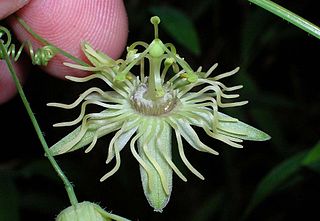
The macula or macula lutea is an oval-shaped pigmented area near the center of the retina of the human eye and some other animalian eyes. The macula in humans has a diameter of around 5.5 mm (0.22 in) and is subdivided into the umbo, foveola, foveal avascular zone, fovea, parafovea, and perifovea areas.

Nelumbo lutea is a species of flowering plant in the family Nelumbonaceae. Common names include American lotus, yellow lotus, water-chinquapin, and volée. It is native to North America. The Linnaean binomial Nelumbo lutea (Willd.) is the currently recognized name for this species, which has been classified under the former names Nelumbium luteum and Nelumbo pentapetala, among others.

Gagea lutea, the yellow star-of-Bethlehem, is a Eurasian flowering plant species in the family Liliaceae. It is widespread in central Europe with scattered populations in Great Britain, Spain and Norway to Siberia and Japan.

The buff ermine is a moth of the family Erebidae. It is sometimes placed in the genus Spilosoma. It is found throughout the temperate belt of the Palearctic region south to northern Turkey, Georgia, Kazakhstan, southern Siberia, Eastern Mongolia, Amur Region, China, Korea and Japan.

Gentiana lutea, the great yellow gentian, is a species of gentian native to the mountains of central and southern Europe.

Passiflora lutea, the yellow passionflower, is a flowering plant in the family Passifloraceae, native North America, in the eastern and south-central parts of the United States from Pennsylvania west to Kansas, and south to Florida and Texas. It is the northernmost species of Passiflora, occurring slightly further north than P. incarnata, and tolerant of winter temperatures down to −15 °C, and even −30 °C for short periods.

Viola lutea, also known as the mountain pansy, is a species of violet that grows in Europe, from the British Isles to the Balkans.

Nuphar lutea, the yellow water-lily, or brandy-bottle, is an aquatic plant of the family Nymphaeaceae, native to temperate regions of Europe, northwest Africa, and western Asia.

Sternbergia lutea, the winter daffodil, autumn daffodil, fall daffodil, lily-of-the-field, or yellow autumn crocus, is a bulbous flowering plant in the family Amaryllidaceae, subfamily Amaryllidoideae, which is used as an ornamental plant. It has yellow flowers which appear in autumn.

Oberea is a genus of longhorn beetles, most of which are stem borers of various plants, including blackberries and their relatives.
Isochrysis is a genus of haptophytes. It includes the species Isochrysis galbana, Isochrysis litoralis and Isochrysis maritima.

Trapezites lutea, the rare white spot skipper, is a butterfly of the family Hesperiidae. It is found in Australia in the states of New South Wales, Victoria, South Australia and Tasmania.

Asphodeline lutea is a perennial plant native to southeastern Europe, northern Africa, the Caucasus and the Levant. It is grown as a landscaping plant.

Pinguicula lutea, commonly known as the yellow butterwort, is a species of warm-temperate carnivorous plant in the Lentibulariaceae family. It grows in savannas and sandy bog areas of the Southeastern United States.

The Yellow-spotted snake eel is an eel in the family Ophichthidae. It was described by John Otterbein Snyder in 1904.
Oberea rubetra is a species of beetle in the family Cerambycidae. It was described by Francis Polkinghorne Pascoe in 1858. It is known from Sumatra, Borneo and Malaysia.
Oberea erythrostoma is a species of beetle in the family Cerambycidae. It was described by Heller in 1915. It is known from the Philippines.
Oberea ferruginea is a species of beetle in the family Cerambycidae. It was described by Thunberg in 1787.
Oberea fuscipennis is a species of beetle in the family Cerambycidae. It was described by Chevrolat in 1852.














